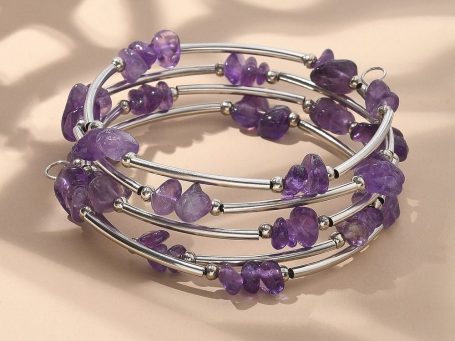18
JUN
2024
Bracelet Types
A bracelet is an article of jewellery that is worn around the wrist. The origin of the term 'bracelet' is from the Greek brachile meaning 'of the arm', via the Old French bracel. A bracelet is also a small brace or bracer (an arm-guard used by archers).
If a bracelet is a single, inflexible loop, it is often called a bangle. When it is worn around the ankle it is called an ankle bracelet or anklet. A boot bracelet is used to decorate boots.
Although the term armlet may be technically similar, it is taken to mean an item that sits on the upper shoulder: an arm ring.
Types of bracelets
Alternative health
Alternative health bracelets, such as ionized bracelets, karma bracelets, magnetic bracelets, Power Balance hologram bracelets, etc, are not distinguished by their design but rather the beneficial function claimed for them by their manufacturers and distributors. Karma bracelets are made from wood beads and may contain various charms, and are associated with bringing good luck and good karma to those who choose to wear it. No claims of effectiveness made by manufacturers have ever been substantiated by independent sources.
Bangles
Hard material or rigid bracelets, usually made from metal, wood, or plastic, are referred to as bangles. They can be smooth, textured or set with stones.
Beaded
Usually made from loose beads with a centre hole and connected by a piece of string or elastic band through the holes. Most often made with wooden beads, plastic, glass or even crystal beads.
Charm
A charm bracelet carries pendants or trinkets which can be signifiers of important things, interests/hobbies, and memories in the wearer's life.
Elastic
Made from an elastic fabric or spandex material, elastic bracelets are typically sublimation printed with colourful designs and reversible. First created and made popular in the early 2010s, they've become more popular in the past decade.
Link
Bracelets made from connecting or linking various or similar components or jewellery findings. Link bracelets can be made of a variety of materials including metals and gemstones.
Penannular
Penannular, meaning an incomplete circle, has been a very common form for bracelets, especially ones made in a single piece of a slightly flexible material such as metal or plastic. It is particularly popular in gold.
Slap
In the late 1980s and early 1990s, "slap bracelets"—flat, felt-covered metal strips that curved around one's wrist when gently hit against it—were a popular fad. Often adorned with neon colours and vivid graphics, these bracelets could be found at inexpensive retailers.
Sports
The use of coloured silicone rubber as a material for producing sports bracelets was popularised in May 2003. Their success has led to the silicone bracelet becoming a low cost tool for various awareness, information, and charity campaigns. This can be likened to the use of awareness ribbons for similar purposes. These bracelets are also known as "baller id bands", "baller bands" or "wristbands". They can also be referred to as rubber wristbands, silicone wristbands or gel wristbands. For sport climbing, bracelets are designed with climbing cords to serve as a mountain climbing gear.
Tennis
While playing a match at the 1978 US Open, tennis player Chris Evert was wearing a diamond line bracelet, which fell from her wrist to the surface of the court. She said about this, "I dropped my tennis bracelet", and since then diamond line bracelets have also been called "tennis bracelets". The term tennis bracelet appears in print before this incident, but not necessarily referring to diamond line bracelets.
Tennis bracelets are made up of many identical settings, each of which incorporates a hinge. The links are usually riveted or soldered from the sides of the bracelet allowing it to flex freely around the wrist with minimal movement left-to-right. A typical tennis bracelet will feature round diamonds set in four claw settings. Tennis bracelets can be adjusted to fit the wearer by removing links, this must be done by a jeweller.

We need your consent to load the translations
We use a third-party service to translate the website content that may collect data about your activity. Please review the details in the privacy policy and accept the service to view the translations.


